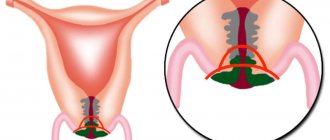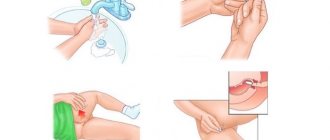Hexicon suppositories are successfully used as part of complex therapy for many gynecological diseases due to their antimicrobial effect. Suppositories, called Hexicon, have also found their use in the treatment of cervical erosion.
Among the background benign pathologies of the cervix, erosion occupies a special place. This pathology has no clinical manifestations and does not affect hormonal levels. However, in the absence of timely diagnosis and treatment, the disease can pose a serious threat to health.
Gynecologists say that at present the diagnosis, which sounds like erosion, is not entirely correct. Literally, erosion means a violation of the integrity of the epithelium, which occurs only with one type of this pathology - true.
In most cases, erosion is diagnosed in the form of ectopia, which means the replacement of one type of epithelium with another. Since in 80% of cases it is not the wound surface that is diagnosed, but the result of replacement, it is more correct to call the pathology ectopia. Thus, erosion represents several cervical conditions that differ in both etiology and pathogenesis.
The cervix is the lowest part of the uterus, which looks like a muscular tube. The cervix represents an important function. It connects the uterine body and the vagina, and the cervical canal protects the organ cavity from infections.
In the development of pathology, cylindrical cells lining the surface of the cervical canal and giving it a reddish tint and velvety texture are of significant importance. In addition, glands function inside the cervical canal, producing mucus.
Normally, the surface of the cervix, which is adjacent to the vagina, has a pale pink color and an even texture. The specific structure of the mucosa is provided by flat cells, which are arranged in several layers.
From below, the cervical canal forms a pharynx, called the external pharynx. In this area, the junction of flat and columnar epithelium occurs. This area is an invisible transformation zone. It is here that true erosion most often occurs, against the background of which ectopia is formed.
What is cervical erosion and why is it dangerous?
Before we talk about treating erosion with hexicon suppositories, you need to understand the disease a little. Thus, cervical erosion is not one disease, but a general name for a group of diseases in which destruction (ulcerative lesions) of the mucous membrane of the cervix occurs. Often erosions are a consequence of other gynecological diseases or this organ. Experts have already abandoned the term erosion. Now this phenomenon is called ectopia. But the damage to the mucous membrane itself has not changed. Some doctors claim that almost all women have ectopia of the cervix. But this does not mean that treatment for erosion is not necessary. The fact is that where there is a defect, pathogenic microorganisms can begin to multiply and inflammation can develop. It can spread to other female organs and cause infertility. The consequence of erosion can be cancer of the cervix and not only it. Therefore, treatment for this problem is necessary.
Treatment of erosion can be surgical and using laser coagulation, cryodestruction, as well as diathermocoagulation (burning with electric current). If the ectopia is not very pronounced, treatment with vaginal suppositories is also suitable, among which Hexicon is popular. Also, treatment with suppositories can be prescribed as preparation for other types of treatment or after them.
On the left in the photo is a healthy cervix, on the right is one affected by erosion
Etiology and pathogenesis
The mechanism of development of an erosive spot is poorly understood. Experts identify many factors that influence the appearance of spots in the cervical area.
It is known that each type of erosion has its own causes. In general, among the factors contributing to the destruction of healthy squamous epithelium are:
- hormonal fluctuations that occur during menopause, pregnancy or puberty;
- intrauterine features of the development of the genital organs;
- sexual infections;
- multiple sexual partners;
- chemical spermicides;
- cervical injuries caused by surgical termination of pregnancy, difficult childbirth, curettage, and inaccurate sexual intercourse.
The pathogenesis of cervical erosion is determined by its type. With true erosion, the wound surface is determined as a result of the destruction of the epithelium, which often contains various infectious agents. True erosion may bleed during a gynecological examination.
Congenital ectopia is formed in utero. The vaginal area of the cervix is covered with cylindrical cells, and the transformation zone shifts and can be determined when examined in mirrors. Signs of inflammation are common if the defect does not regress after twenty-five years.
Pseudo-erosion, unlike a congenital defect, is a spot of different sizes and shapes. With acquired ectopia, in most cases there is a concomitant infectious process. Pseudo-erosion is destroyed using various cauterization techniques.
There is no specific clinical picture for ulcerative defect. As a result of the functioning of the glands of cylindrical cells, increased mucus production occurs on the surface of the erosion.
This leads to the appearance of characteristic mucous discharge. It is also possible that contact discharge may appear after sexual intercourse or examination by a gynecologist.
Hexicon: properties and principle of operation
The active ingredient of hexicon is the antiseptic chlorhexidine, i.e. Chlorhexidini bigluconas. From a chemical point of view, chlorhexidine is a dichlorine-containing biguanide derivative. The popularity of chlorhexidine is due to its wide range of capabilities - this antiseptic destroys many types of bacteria and can even stop the development of caries. Chlorhexidine can be produced in the form of wipes, catheters and lubricants, it is impregnated with medical clothing, and it is contained in implants. It is used to treat the hands of doctors and the surgical field before operations, as well as medical devices, and it is used to wash wounds after operations. I produce it in the form of a gel, solution and suppositories.
Hexicon works by interacting with various phosphate groups on cell surfaces, which causes the osmotic balance to be disrupted and the cell to die.
Chlorhexidine has a detrimental effect on the following microorganisms:
- Ureaplasma spp.;
- chlamydia;
- treponema pallidum;
- neisseria gonorrhoeae;
- herpes virus
- bacteroides fragilis (with the exception of mycobacterium tuberculosis);
- gardnerella vaginalis;
- trichomonas vaginalis and others.
The product has not only anti-inflammatory, but also anti-edematous properties.
The drug Hexicon relieves swelling and inflammation
hexicon suppositories for cervical erosion
Good afternoon everyone. Sorry it’s so long. From the day menstruation appeared, their flow was irregular and painful. At the age of 19 there was a six-month delay. Which led to a trip to a gynecologist-endocrinologist. Conclusions (for the period of absence of menstruation): 1. Low progesterone (blood for hormones); 2. Stage 1 hypoplasia, bilateral persistence of follicles. Hormonal treatment was prescribed, but it did not come to fruition because a history of sexually transmitted infections began (i.e., the appearance of a new partner). I already had my period. • January 2008. in the state hospital. Tests: Cytology - inflammation.
S I B Gonococci n/o 0-2 n/o leukocytes 70-80 2-3 10-15 Microflora Coccus + nar? Trichomonas n/a Klyuchev. cells n/o Epit. cells moderately
RIF method: Chlamydia (cit) - detected Trichomonas not detected Mycoplasma negative. Control ultrasound: persistence of the corpus luteum on the right. Treatment: Ornidazole, hexekon, ginesol, fluconazole.
• Throughout the year there was heavy discharge, burning, itching, and it turned into a cheesy discharge. Symptoms: redness and pimples, itching, burning, pain during intercourse, cheesy discharge. Took tests: Cytology - inflammation. S I V Gonococci n/o n/o n/o leukocytes 40-45 0-2 10-20 Microflora Cocci abundant Trichomonas n/o Epit. cells Significantly Method RIF: Chlamydia - negative Trichomonas - detected Mycoplasma - positive HSV-2 - negative Treatment: 1. Candide gel 10 days 2. Ornidazole, hexicon, iodoxide 3. Macropen 2 packs, cycloferon.
• Control after 2 months. S I B Gonococci n/o n/o leukocytes Densely Microflora normal Trichomonas n/o Key. cells n/o Fungi n/o RIF method: Mycoplasmas - positive
And we didn’t watch anything else!!!!!!!!!!!!!!!!!!!!!!!!!!! The tests look bad. The doctor is not attentive. !!!!!!!!!I took the tests and went to a private clinic. The doctor trusted the tests (because it turned out that I was being observed by her teacher) and in vain!!!!! Treatment: 1. Candles made by the state. Pharmacy, composition: metronidazole 500, clarithromycin?., vitamin E. 2. Doxycycline. 3.Proteflazid (tampons daily).
• Control after 2 months. From another doctor. PIF: Chlamydia - positive Trichomonas - negative Mycoplasma - positive Treatment: 1. sumamed 1g every 7 days. 3 weeks. 2. “Vita Line”: Grapefruit extract, Pau da Arco (Lapaccio root). 3. Bifidumbacterin suppositories.\
• Control after 2 months. For the spouse:
Mycoplasma hominis DNA, PLR - not detected Mycoplasma genitalium DNA, PLR - not detected Ureaplasma urealiticum DNA, PLR - not detected Trichomonas vaginalis DNA, PLR - not detected Chlamydia trachomatis DNA, PLR - not detected
Result of a microscopic examination of a urogenital smear Urethra: - Single leukocytes - Microflora: Rods Gr (+) not detected Sticks Gr ( - ) not detected Cocci Gr (+) single - Diplococci (extracellular) Gr (+)( - ) not detected (intracellular) Gr (+)( - ) not detected - Candida sp.: spores - not detected Mycelium - not detected - Trichomonas - not detected - Epithelium (urethra) - not significant Represented by columnar epithelial cells located: - separately, in groups. squamous epithelial cells - revealed Representations by cells: - intermediate - single - Mucus - moderate
I have: Chlamydia trachomatis DNA, PLR - not detected
Detections of M.hominis and U.urealiticum - In a low titer 10000CCU/ml The growth of M. hominis was not detected Detections of M.hominis and U.urealiticum - In a low titer 10000CCU/ml The growth of U. urealiticum was not detected
Result of a microscopic examination of a urogenital smear Vagina: - Leukocytes 5-10 in the field of view, up to 40-50 in places of accumulation on the mucus - Microflora: Rods Gr (+) significantly Sticks Gr ( - ) not detected Cocci Gr (+) ( - ) not detected -Diplococci (extracell) Gr (+)( - ) not detected (intracell) Gr (+)( - ) not detected - “Key” cells - not detected - Candida sp.: spores - not detected Mycelium - not identified - Trichomonads - not detected - Epithelium Represented by cells: superficial - slightly Perineal - significantly parabasal - not detected Cytolysis not pronounced cervical canal: - Leukocytes - 10-15 in the field of view, up to 60-70 in places of accumulation on the mucus - Epithelium of the cervical canal - single (cells of the cervical canal epithelium) urethra: - Leukocytes - single in the pre, in the field of view - places of accumulation - Urethral epithelium - without features
• The time has come to start hormonal treatment, but erosion has appeared. Treatment: 1. Vulnizan ointment for 10 days (tampons). 2. women's comfort, evening primrose (Vita Line - dietary supplements). - 3 months.
After the lake, the following symptoms began: itching, burning, cheesy discharge, fishy smell, copious discharge. Self-medication: hexicon, fluconazole. The signs have not disappeared. After 2 weeks:
The result of a microscopic examination of a urogenital smear of the vagina: ● Leukocytes 10-20 in the field of view in places of accumulation ● Microflora: Rods Gr (+) Moderate Rods Gr ( — ) not detected Cocci Gr (+) significantly Diplococci (extracellular) Gr (+)( — ) single (intracellular) Gr (+)( - ) not identified “Key” cells - not identified Candida sp.: spores - solitary Mycelium - not significant ● Trichomonas - not identified ● Epithelium is located - separately, in groups. Represented by cells: superficial - significantly Perineal - moderate cervical canal: ● Leukocytes 20-40, in the field of view 130 on mucus ● Microflora: Rods Gr (+) - not significant Rods Gr ( - ) - not detected Cocci Gr (+) - not significantly Cocci Gr ( - ) - not detected Diplococci (extracellular) Gr (+) single (extracellular) Gr ( - ) not detected (intracellular) Gr (+) ( - ) ( - ) not detected Candida sp.: spores - not detected mycelium not detected ● Trichomonas - not detected ● Epithelium - detected, single epithelium of the cervical canal - single, without features (cells of the salous epithelium) urethra: ● Single leukocytes in the preparation, in the field of view - places of accumulation ● Microflora: Rods Gr (+) - single Rods Gr ( - ) - not detected Cocci Gr (+) - single Diplococci (extracellular) Gr (+) - single (intracellular) Gr (+)( - ) - not detected ● Trichomonas - not detected
Cytology 1. Material from the cervix Leukocytes 1-5 p/z Flora: rods, cocci, diplococci. The epithelium of the cervix is represented by cells: Superficial significantly Intermediate moderately Parabasal not detected Cytolysis not expressed Metaplastic cells not detected Zalous epithelial cells not detected Impurities: erythrocytes not detected, mucus not significantly 2. Material from the cervical canal: Leukocytes on mucus: >50 in p/ zren With signs of proliferation of the malignant epithelium. Metaplastic cells were not detected. Cells of the salous epithelium were not significant. Impurities: single red blood cells, moderate mucus. Squamous epithelial cells were not significant. 3. Infections: Kindida (By the way, ultrasound confirmed ovulation - regular menstruation. Calposcopy - ectopia of the cylindrical epithelium in the 1st zone.)
Treatment: 1. Candide gel 2. Milagin suppositories 3. Fluconorm 150 mg once every 7 days, 14 days.
• Symptoms have not disappeared. A smear revealed Candida. Treatment:1. Neo-Penotran suppositories. 2. Zolain candles for 1 day\7 days. 2 candles. 3. Itraconazole 2t/2r (2 days) then every other day. Total 15 pcs.
The symptoms did not disappear. - fishy smell; -itching; -burning. - pain in the lower abdomen. What to do? Tell. Perhaps there is a problem with the immune system? I no longer have the strength to take care of myself. The other day I was admitted with suspected appendicitis, but it turned out to be gynecology.!
Use in gynecology
Chlorhexidine for the treatment of gynecological diseases is available in the form of suppositories. They contain chlorhexidine bigluconate in the amount of 0.016 g (children's suppositories of chlorhexidine contain half as much). The remaining components are polyethylene epoxides.
The indications are:
- Vaginitis of various origins;
- Candidiasis (in combination, to relieve swelling and inflammation);
- exocervicitis and endocervicitis (both chronic and acute);
- prophylactic before insertion of an intrauterine device, childbirth, surgery, abortion;
- to prevent chlamydia, ureaplasmosis, trichomoniasis, gonorrhea, syphilis.
Contraindications for use may include dermatitis, allergies and intolerance or sensitivity to the components of the suppositories.
Hexicon has low absorption and can be used during pregnancy and breastfeeding.
Among the side effects, only itching in the genitals (allergic) is noted, which goes away after the end of treatment. Chlorhexidine is not used during menstruation, so you need to decide on the start and end dates of treatment so that they do not fall on menarche.
Important: when treating ectopia and gynecological diseases with Hexicon, you should not introduce detergents (soap and detergents) that contain an anionic group (sodium carboxymethylcellulose, saponins and also sodium lauryl sulfate) into the vagina.
Vaginitis is an indication for taking Hexicon
Treatment of ectopia: methods and their features
If infection is added to erosion, which is accompanied by pus, bleeding, pain, treatment of the disease will last much longer than in uncomplicated cases.
Conservative treatment
Currently, several approaches to the treatment of erosion are practiced. Conservative methods are considered ineffective in many cases, but they should not be neglected under the following conditions:
- Monitoring the condition of congenital erosion.
- If the disease is active, suppositories (for example, Hexicon), sprays and tampons can be used for local action.
- Elimination of factors provoking erosion.
- In case of inflammation, it is important to eliminate the infectious agent from the body.
Indications for conservative treatment are the following manifestations of pathology:
- tissue injury during childbirth;
- injury during abortion;
- venereal disease, which led to erosion;
- reduced immunity;
- disturbances of the natural microflora of the vagina;
- hormonal disorders;
- vaginal discharge with an unpleasant odor;
- inflammation in the genitals or urinary tract.
But even with such indications, Hexicon (or its analogue) is not always prescribed. Suppositories can be used in the treatment of erosion only in case of minor damage to the epithelium - up to 20 mm.
Cauterization
For ectopia, various types of cauterization can be used:
- radio wave;
- chemical;
- cryodestruction;
- laser;
- diathermocoagulation.
After cauterization of erosion, Hexicon is prescribed for preventive purposes. This allows you to prevent the development of infection and, as a result, will contribute to better healing and tissue regeneration.
Important! Without treatment, complications are added to erosion, which cover more and more tissues and can provoke serious complications, including oncological processes.
Ectopic cervix
For cervical erosion, the remedy is effective because it copes with the causative agents of many ailments. Thus, if the cause of inflammation is removed, erosion healing can be achieved. Suppositories alone can be used if the damage to the cervix is minor. If the lesion is more than two centimeters, suppositories are not used. In other cases, other treatment methods are needed, but they can also be combined with suppositories, which will be used in order to consolidate the result.
Hexicon suppositories for the treatment of cervical erosion have advantages:
- Easy to use;
- the mucous membrane is not injured;
- the natural flora is not suppressed, i.e. lactobacilli;
- inflammation goes away quickly.
Before treating ectopia with suppositories, doctors advise undergoing several studies that will help determine the extent of organ damage. This may include tests for excision of cervical tissue affected by ectopia and their microscopic examination, ultrasound, tests of vaginal microflora, colposcopy, and blood tests.
With significant ectopia, stabilization of the patient’s general condition will also be necessary: normalization of metabolism, immunostimulation, anti-inflammatory procedures, stabilization of the menstrual cycle.
Stabilization of the menstrual cycle is the key to successful treatment
Kinds
Gynecologists emphasize that not every case of erosion indicates pathology. Some forms may be temporary, being a variant of the norm.
In gynecology, the following types of erosion are distinguished.
- Congenital. If the process of differentiation of the epithelium into flat and cylindrical is disrupted, the vaginal portion of the cervix becomes covered with cells of the cervical canal. Congenital erosion or ectopia is not a pathology. As the cervical epithelium matures, the spot disappears on its own. There is no treatment for such a defect.
- True. In general, this is the only form of erosion that appears as a wound or ulcer. In the true form, local destruction of epithelial tissue is observed due to various damaging factors. Therapeutic tactics for true erosion are rarely used, since the short period of occurrence does not allow the ulcer to be detected in time.
- Acquired ectopia or pseudo-erosion. This is a consequence of improper healing of the true variety, as a result of which the wound on the cervix regenerates with a cylindrical lining.
Determining the type of defect helps to use adequate therapy and differentiate a benign cervical defect from precancerous conditions and a malignant tumor.
Mode of application
Hexicon helps with inflammation of the ovaries and has virtually no contraindications, except for individual intolerance to chlorhexidine. However, it is recommended to use it only as prescribed by a doctor.
According to the instructions for inflammation, Hexicon suppositories should be used in this way:
- Wash your hands well with soap and treat them with disinfectant.
- Remove the suppository from the plastic packaging.
- Lie on your back and, spreading your legs wide, bend your knees.
- Insert the suppository deep into the vagina.
- Lie quietly for 10 minutes so that the suppository dissolves and the active substance is absorbed into the vaginal walls.
The recommended dosage is 1 suppository 1-2 times a day for a week. In case of severe disease, the gynecologist may extend the course of treatment.
To prevent infection in the absence of contraception, Hexicon must be inserted into the vagina within two hours after sexual intercourse.










